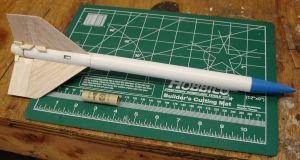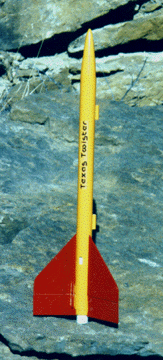| Construction Rating: | starstarstarstarstar |
| Flight Rating: | starstarstarstarstar_border |
| Overall Rating: | starstarstarstarstar_border |
| Manufacturer: | Apogee Components  |

Brief:
The Texas Twister is a paper body tube and balsa fin model rocket with three
moveable fins that flip into position to spin the vehicle during recovery. The
fins are pulled into recovery position using three tiny rubber bands supplied
in the kit. A nifty piston and lock system unlocks the fins from boost position
using ejection charge gas pressure.
Construction:
This is a quality kit and includes two body tubes, a motor mount tube, plastic
nose cone, coupler tube, centering rings, as well as a motor block, hinge
material, and two launch lugs. Also included are the little rubber bands needed
for the fins, a special plastic ring to hold the fins during launch, and a
small decal sheet with two decals.
All instructions should be this good! Six pages of detailed printed instructions including diagrams and numbered steps for each assembly.
 The
balsa included with the kit is among the highest quality I have seen in any
kit. The only special tool needed is a jar of petroleum jelly. This is used to
grease the hinge line on each moveable fin before gluing the hinges. It doesn't
take much. Apogee calls these fins "flaps".
The
balsa included with the kit is among the highest quality I have seen in any
kit. The only special tool needed is a jar of petroleum jelly. This is used to
grease the hinge line on each moveable fin before gluing the hinges. It doesn't
take much. Apogee calls these fins "flaps".
The fit of the plastic nose cone could be a little better. It is OK but it does not quite line up perfectly with the body tube.
The builder must be very careful where he puts the glue on the motor mount/piston assembly. The piston must be free to slide in and out. My kit required some sanding of the centering rings to get it to slide freely. The plans point this out but be careful not to get glue inside where it could jam the sliding movement.

Finishing:
The review model in the pictures was finished with Aero Gloss model airplane
dope in the little glass jars. I bought it at the local hobby shop. Several
light coats of white were brushed on the fins then the yellow was airbrushed
on. One fin was painted black in order to aid in viewing the descent rotation.
Once again, you have to be careful not to paint the sliding motor mount into a
stuck position.
The kit supplies a red and blue "Texas Twister" water slide decal with a picture of the state of Texas and a small Apogee logo decal.
Construction Rating: 5 out of 5
Flight:
Apogee recommended a 1/4A3-3T for the first flight then 1/2A3-2T and A3-4T.
Under this the package cover states "Recommended 13mm Apogee Components
Rocket Motors: B7-6, C6-7. For the first flight I used an A3-4T because that is
what I had on hand. To prepare for flight, be sure all three rubber bands are
placed over the little balsa hooks. There is one hook on the fixed side of each
fin and one on each flap. You must hold all three flaps in the boost position
then slide the plastic retainer ring down over the end of each one
simultaneously, which is not as hard as it sounds. The motor is held in place
with tape. No wadding is required. The initial launch was in boiler plate (no
paint).
The first boost was very straight on the A3-4T. We got about 190 feet!
Recovery:
There is no shock cord on the Texas Twister. Both recoveries were similar, with
a gyrating tumbling spin on the way down. The recovery mechanism worked as
advertised, however, one rubber band "hook" split off just above the
glue line causing a tumbling followed by a few spins and more tumbling. Other
than the broken hook there was no other damage and it was an easy fix. For the
second flight, the model was taken back to the shop, cleaned up, prepped and
painted with Aero Gloss dope. An A10-3T was used for the second flight. The
very bottom of the motor mount tube has torn at the wrap. Not sure how this
happened.
Flight Rating: 4 out of 5
Summary:
This is a very high quality kit with an interesting recovery system. The
instructions can't be beat. This is a very complete kit.
The main CON was the slight misalignment of the plastic nose cone but this was minor.
Not sure if this rocket is supposed to spin down vertically or tumble and spin as mine did. As the engine moves aft during ejection burn, the CG moves way back. I think this is what causes the tumble. I built an Estes Gyroc years ago and was expecting a similar recovery, but this thing is different. It is hard to explain--you just have to see it happen.
Overall Rating: 4 out of 5
![[NAR]](/images/archive/images/link_nartitle.gif)
![[Sport Rocketry]](/images/archive/images/link_sr_logo.gif)
The following excerpt is from "Sport Rocketry". The intention is to allow guests to get a basic feeling about a kit. We strongly suggest that you get a copy of the referenced Sport Rocketry and read the entire article. Inside you will find many helpful hints in construction as well as other useful information. For more information, use the two links above.
(Sport Rocketry - Mar/Apr 2001 - page 37 - by Greg Elder)
 "This fun sport flyer features
helicopter recovery."
"This fun sport flyer features
helicopter recovery."
"...comes with clearly illustrated set of instruction that easily explains
the rocket's construction."
"...includes 18mm body tubes, 10mm motor tube, plastic nose cone, laser
cut balsa fins, a molded plastic flap guide, and water transfer decals."
"...assembles fairly easy."
"The motor tube is constructed like a piston..."
"At launch, the motor piston is placed in a forward position, such that
the flap guide holds the flaps straight, in-line with the fins."
"At ejection, the motor piston will be moved to the rear, thus, releasing
the flaps."
"I found the Texas Twister fun to build and fun to fly..."
The entire article gives the impression that the Texas Twister is slightly challenging but rewarding to build and fly. And that it could be used for competition.
 |
 |
Flights
 |
 |